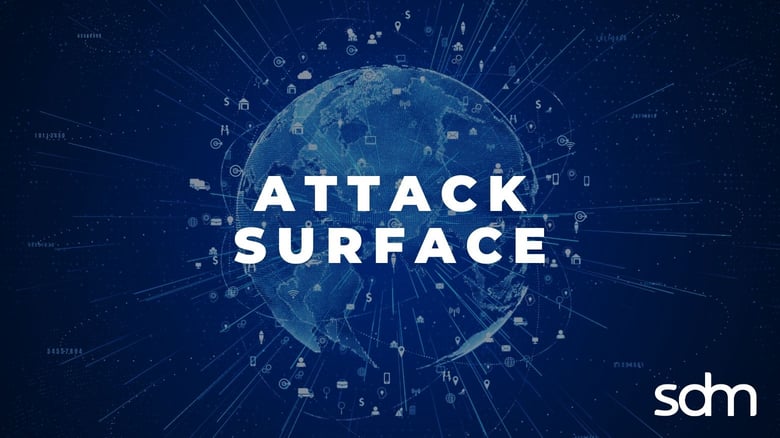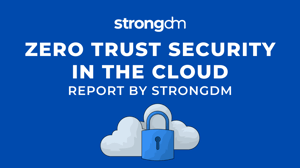
- Role-based, attribute-based, & just-in-time access to infrastructure
- Connect any person or service to any infrastructure, anywhere
- Logging like you've never seen

Summary: Data breaches are a perpetual risk for modern organizations — and the wider your attack surface, the higher your organization’s risk of a breach. In this article, we will take a high-level look at what your attack surface is, what vectors and endpoints may be at risk, and how to analyze your attack surface. By the end of this article, you’ll know how to diminish and manage your attack surface to better protect your organization’s data from hackers and reduce your overall data privacy risk.
What Is an Attack Surface?
Your organization's attack surface is a collection of all the external points where someone could infiltrate your corporate network. Think of your attack surface as any opportunity or vulnerability a bad agent can use to enter part of your IT infrastructure.
A large attack surface contains multiple points where an unauthorized person could gain access to sensitive data like financial records, personally identifiable information (PII) for employees and customers, confidential product or sales information, and more. Reducing your digital footprint, limiting external access points, and strengthening authentication requirements are the best ways to enhance your security posture and mitigate risk.
Why Is a Large Attack Surface a Security Risk?
Without robust security controls in place, managing a large attack surface is a common challenge for security teams. With so many vulnerable endpoints, a single user's compromised credentials can pose a major security risk to your entire network. After all, 20% of all cyberattacks start with compromised credentials.
Once your attack surface is breached, hackers can bypass cybersecurity measures to implant malware or ransomware on your network. These types of breaches can be extremely expensive and time-consuming to remediate, often costing upwards of $4.45 million on average and taking approximately 287 days to contain. By then, the breach has already compromised sensitive data and can substantially damage your company's reputation.
What Are the Different Types of Attack Surfaces?
Often, modern cybersecurity conversations center around one type of attack surface: your company's digital attack surface. However, if your security team is only tracking your organization's digital footprint, you may be leaving yourself vulnerable to unexpected security risks.
Different factors on- and off-line contribute to data security. While companies may have a strategy in place to monitor and protect their digital attack surface, IT risk management still needs to address vulnerabilities on these other fronts, too.
Your Enterprise Risk Management plan must consider five types of attack surfaces:
- Digital Attack Surface
Your digital attack surface contains any external vulnerabilities accessible through the internet, focusing on system access points, websites, ports, and services. Most IT monitoring covers the digital attack surface, but that only represents part of a company’s overall attack surface. - Physical Attack Surface
Physical attack surface covers access points into your company’s hardware, including both equipment on-premises and equipment connecting to corporate networks from outside the office. The physical attack surface also contains access points vulnerable to malicious insider threats, like a rogue employee sharing data outside the organization or allowing unauthorized entry into an office. - Social Engineering Attack Surface
Social engineering — when attackers leverage psychology to convince users to expose sensitive data or passwords — can pose a challenge to both digital and physical attack surface protection. This can include bad actors posing as employees to gain information, capturing credentials through a phishing technique, or sharing infected files with an employee. Social engineering attack surface covers both malicious insider threats and external threats preying on employees with limited security knowledge. - Artificial Intelligence (AI) Attack Surface
AI algorithms can be subject to adversarial machine learning, which exposes weaknesses companies may have never anticipated. Since these types of attacks can't be patched like traditional software, it's harder to protect against potential threats. Plus, a malicious actor doesn't even need credentials to infiltrate an algorithm; all they need to do is present harmful data to manipulate the AI system. Experts claim that hacking AI systems is even easier than accessing conventional IT systems.
- Internet of Things (IoT) Attack Surface
While 69% of companies have IoT devices that outnumber computers on their network, only 16% of companies have IoT attack surface visibility, according to a commissioned study conducted by Forrester Consulting on behalf of Armis. Data leaks and Denial-of-Service (DoS) attacks threaten IoT configurations, especially if users don't install critical software updates. As IoT technology rapidly expands, security measures must keep up so hackers who access an IoT device can’t infiltrate other devices on the network.
Each of these attack surfaces contain hundreds to thousands of attack vector types, so it’s critical to represent all five types in a comprehensive enterprise security plan.
What Is an Attack Vector and How Are Attack Surfaces Related?
An attack vector is any vulnerable pathway that allows bad actors access to your company's sensitive data. A vector is both the vulnerable point itself and the method used for unauthorized access, so each attack surface contains a wide array of potential attack vectors. The larger an attack surface is, the more attack vectors it holds.
Any attack vector, if accessed by an unauthorized user, opens the door to potential data breaches or increases the likelihood of malware and ransomware attacks. Most companies have tons of vulnerable attack vectors that could pose security issues, but they may not have the visibility or threat intelligence necessary to secure these points.
What Are the Different Types of Attack Vectors?
It's not uncommon for companies to have hundreds of potential attack vectors across large threat surfaces. While many organizations have security measures in place to prevent successful attacks, these companies can only protect against weaknesses they can see.
These attack vector types are most common:
- Compromised credentials, often caused by weak passwords or passwords stored in plain text
- Manipulated employees who fall victim to phishing attacks or granting access to an unauthorized internal or external user
- Malicious insiders who intentionally share PII, sensitive data, or credentials
- Missing or poor encryption practices, like expired SSL certificates, vulnerable data transfer protocols, and other man-in-the-middle attacks
- Distributed Denial of Services (DDoS) attacks, which overwhelm and crash a network with excessive traffic
- Misconfigured services and infrastructure
- Transferred, shared, or stored data with third-party vendors
- Unpatched and unpredictable zero-day vulnerabilities
These attack vector vulnerabilities present opportunities for brute force attacks and allow bad actors to carry out ransomware attacks, SQL injections, cross-site scripting, and other malware injection cyberattacks that threaten your company or your customers' sensitive data.
Remote work presents even more chances for unauthorized users to gain access to network endpoints and weaken your cybersecurity posture, even if employees use a VPN to connect to a home or public network. Transferring company data to a personal device or using a corporate device for projects unrelated to work becomes more common when employees work from home, presenting potential data leaks that could threaten your organization.
Less common attack vector types — like unlocked computers in an office setting, stolen biometric access data, and algorithm manipulation — may have a lower level of attackability; however, that doesn't mean they shouldn't be considered as part of your IT risk management plan. All of these vectors and more expand your attack surface area and present ways hackers can infiltrate your organization’s IT infrastructure.
Learn more about different types of Attack Vectors.
How to Perform an Attack Surface Analysis
Without visibility into the attack vectors that make up your attack surface, there’s little your organization can do to protect against a breach. An attack surface analysis helps your security team view your IT infrastructure from the perspective of a hacker to strengthen your security posture. It’s a valuable tool to better understand opportunities for attack surface reduction and expose future risks your organization may face.
Learning how to do a comprehensive attack surface analysis on your own can be challenging, especially for large enterprises with various user permission types. It helps to use an attack surface analysis checklist to recognize blindspots and capture all of your company’s potential attack vectors.
Attack Surface Analysis Example
On a high level, your attack surface analysis consists of four essential steps:
1. Identify every vulnerability where data can enter or exit your network for each of your attack surface types.
- For your digital attack surface, examining your source code and mapping entry and exit points is a good place to start.
- For your physical attack surface, HR teams can help assess social engineering threats and work with IT to strengthen in-office access practices.
- Gain support from data analysis teams to identify IoT and AI attack surface cybersecurity threats.
2. Deeply understand your user types and permissions. Question who touches which access points, when they need them, and how often they access them to determine reliable performance baselines.
- Gain clarity on what users do and don’t need to complete their work. Double check that permissions align with user needs, especially on new configurations, and confirm permissions follow the Principle of Least Privilege.
- Review the policies in place for giving and removing permissions from users as they enter and exit the organization.
3. Measure vector risk and back up sensitive data and PII.
- Understand what data is easily accessible from each vector and measure the risk for individual vectors and overall attack surface, especially remote entry points and vectors exposed to many users or use cases.
- Leverage monitoring and vulnerability scanning tools to examine digital attack vectors. Give special attention to custom-designed solutions, old protocols and code libraries, and security code.
4. Create an action plan for responding to breaches and security threats.
- Review your risky attack vectors to find opportunities to strengthen security practices and monitoring.
- Explore ways to improve Privileged Access Management (PAM) and reduce the number of users with access to each vector.
- When adding new vectors, perform a new risk assessment and add it to your breach response plan.
How to Reduce Attack Surface
The best way to mitigate cybersecurity risks is through attack surface reduction. By securing vulnerable attack vectors and removing unnecessary access points, your security team can effectively protect your company’s sensitive data.
One essential attack surface reduction method is managing access and user permissions, focusing on revoking access or adjusting a user type’s level of access. Review network usage reports to determine regular traffic patterns and bandwidth utilization, adding this information to your attack surface analysis to track. Monitor network health scans alongside network usage baselines to help you discover vulnerabilities early and mitigate risk.
Your team should also review your code and assets regularly, cleaning up expired or outdated data and code to reduce your organization’s digital footprint. Regularly scheduled cleanup events ensure vulnerable access points are removed before they present a threat.
✨ Learn the two ways in which Ironclad reduced its attack surface.
Attack Surface Reduction Best Practices
Your attack surface analysis reveals tons of opportunities to reduce or narrow your attack surface by shifting your security methodology. Managing access is critical for reducing attack surface, so transitioning to a SASE architecture model with Adaptive Cloud Security protects against unauthorized users reaching your sensitive data, no matter where it’s stored.
Leveraging a Zero Trust security model provides advanced protection by ensuring that authorized users are regularly validated before accessing a network. Your team can even add an extra layer of protection with authentication policies based on roles or attributes to further protect against cyber threats and malicious users.
Attack Surface Management
Attack surface reduction is only part of creating an overarching attack surface management plan. Managing your organization’s attack surface and preventing a breach involves constant vigilance through maintaining robust security practices and regular reporting to catch abnormalities early.
Attack surface protection is easier when you partner with other areas of the business to help define and reinforce strong security policies. For example, work with HR to define how often employees should be changing passwords and strengthen onboarding processes to ensure employees start work with the right access. HR can also help your team revoke access quickly by notifying you of employee changes.
Partnering with managers across the business can make a big difference in managing and minimizing attack surface area, too. Managers can help shift office culture by encouraging employees to only work from home or corporate networks rather than using public networks. Plus, managers have more insight into how employees act in the office, so they can reduce the likelihood of social engineering ploys and recognize employees who may pose a risk to your attack surface.
Protect Your Organization with Attack Surface Management
Vulnerability management is essential for modern organizations to avoid falling victim to persistent breach threats. However, businesses often underestimate the number of vulnerabilities across their IT infrastructure that could present opportunities for unauthorized access.
Analyzing and reducing your organization’s attack vectors from the perspective of a bad agent can reveal some surprising weaknesses in your security posture. But, by leveraging that information to strengthen your security policies and practices, your organization can substantially reduce the likelihood of exposing sensitive data in the event of a breach.
If you want to learn more about how StrongDM can help you mitigate risk across your attack surface, contact our experts today for a free demo.
About the Author
John Martinez, Technical Evangelist, has had a long 30+ year career in systems engineering and architecture, but has spent the last 13+ years working on the Cloud, and specifically, Cloud Security. He's currently the Technical Evangelist at StrongDM, taking the message of Zero Trust Privileged Access Management (PAM) to the world. As a practitioner, he architected and created cloud automation, DevOps, and security and compliance solutions at Netflix and Adobe. He worked closely with customers at Evident.io, where he was telling the world about how cloud security should be done at conferences, meetups and customer sessions. Before coming to StrongDM, he lead an innovations and solutions team at Palo Alto Networks, working across many of the company's security products.

You May Also Like





